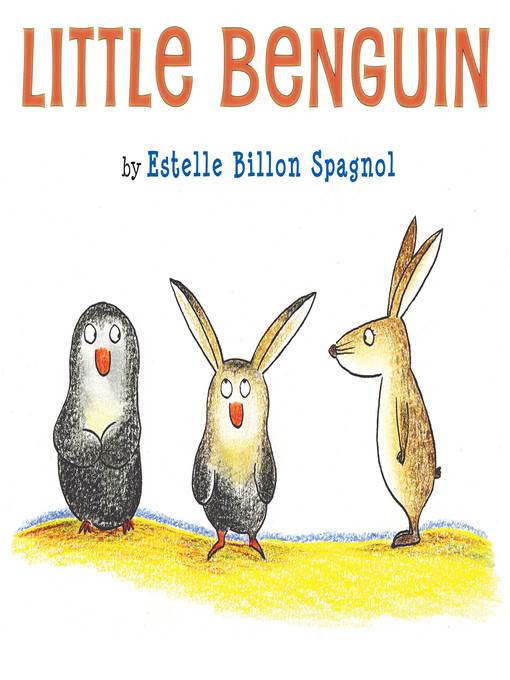
Little Benguin
فرمت کتاب
ebook
تاریخ انتشار
2014
Reading Level
0-1
ATOS
1.7
Interest Level
K-3(LG)
نویسنده
Estelle Billon Spagnolناشر
Holiday Houseشابک
9780823430956
کتاب های مرتبط
- اطلاعات
- نقد و بررسی
- دیدگاه کاربران
نقد و بررسی

December 23, 2013
Originally published in France in 2011, Spagnol's U.S. debut introduces a penguin-rabbit hybrid who is an outcast because he's "unusual." The product of a whirlwind romance (the opening scene shows a blushing penguin and rabbit gazing at each other over a martini glass with two straws), Little Benguin has "Long ears like a bunny. Flippers like a penguin." While Little Benguin is generally at ease in his own skin/fur/feathers, the other animals shun him. "I can't look at those big ears!" sobs a penguin. "Don't play with him," a mother rabbit tells her children. "He has flippers." The arrival of a threatening wolf lets Little Penguin save the day, changing public opinion. Spagnol sets her crayony illustrations against white backdrops, emphasizing the characters' emotions; she's especially good at narrowed eyes, using them to convey the prejudice of Little Benguin's neighbors, the wolf's viciousness, and Little Penguin's determination as he outruns and outswims the predator. The only drawback: the underlying message that it's up to those who are perceived as different to prove their worth to the "normal" masses. Ages 4â8.

February 1, 2014
Manifestly good intentions and charming illustrations can't rescue this high-concept, lead-footed tale, burdened with wince-inducing subtext. Hatched from the happy, mixed-species union of penguin (dad) and rabbit (mom)--Little Benguin greets the world--only to be instantly rejected. "Because Little Benguin was unusual, people were afraid of him. And because people were afraid, Little Benguin was alone." Unispecies age mates jeer at his looks; his self-esteem plummets ("I am an alien. I am a monster"); his parents worry uselessly. He longs to be "normal." When a hungry wolf shows up, Little Benguin leads him away, using superskills--running, swimming--his mixed-species heritage has given him. Throughout, the plot relies on dated, offensive plant- and animal-breeding stereotypes. Grateful fair-weather friends throw a party in his honor. (Disconnected from the grim content, the sunny art seems to have wandered in from a different story.) Questions are begged: Why is it assumed that being mixed will prompt universal rejection? What if the wolf hadn't shown up? Why is it up to Little Benguin to prove himself acceptable to the majority? Who gets to define what is "normal"? Tackling xenophobia, racial and otherwise, in a picture book is a worthy goal, but replacing negative with positive stereotypes doesn't achieve it. Skip the dated allegory and seek out Arnold Adoff and Jacqueline Woodson instead. (Picture book. 3-5)
COPYRIGHT(2014) Kirkus Reviews, ALL RIGHTS RESERVED.

March 1, 2014
K-Gr 2-The child of a penguin and a bunny, Little Benguin doesn't feel like he fits in anywhere. Though his parents "loved their child just the way he was," they "worried about his social life." Bullied and excluded from playing with other animals, he longs to be "normal." When a wolf shows up looking for his next meal, Benguin uses both his special bunny running skills and his superb penguin swimming skills to escape and defeat the wolf. His former tormentors hold a party in honor of the "unique and wonderful and amazing Little Benguin," and he meets the love of his life, a turtle. Though Spagnol's illustrations are endearing and her message a valuable one, the execution is heavy-handed and unlikely to resonate with her intended audience. The contrived conflict and unrealistic resolution add little to the already impressive catalog of subtle and empowering picture books about being different and the issue of bullying.-Jenna Boles, Greene County Public Library, Beavercreek, OH
Copyright 2014 School Library Journal, LLC Used with permission.

March 15, 2014
Preschool-G This book, originally published in France in 2011, is the first of Spagnol's to be translated into English, and it's a charming package containing a powerful message about self-acceptance and diversity. A rabbit and a penguin meet on a tropical isle, fall in love, and marrythe rabbit in high-top boots and a veil, and the penguin in a top hat. On the same page, an egg appears, cracking open comically to reveal a baby that is part bunny, part penguin. The island creatures initially fear Little Benguin because he is different. But one day, a wolf invades the island, and Benguin uses his rabbit feet to outrun the wolf, and then his penguin flippers to outswim him, leaving the wolf running on the bottom of the sea. The islanders are saved and now can appreciate Benguin's special gifts. Spagnol's jolly crayon illustrations fit the tropical atmosphere and jaunty mood, all the way up until an ending that promises more interspecies fun: And on that day, a turtle and a penguin-bunny fell in love. (Reprinted with permission of Booklist, copyright 2014, American Library Association.)

























دیدگاه کاربران